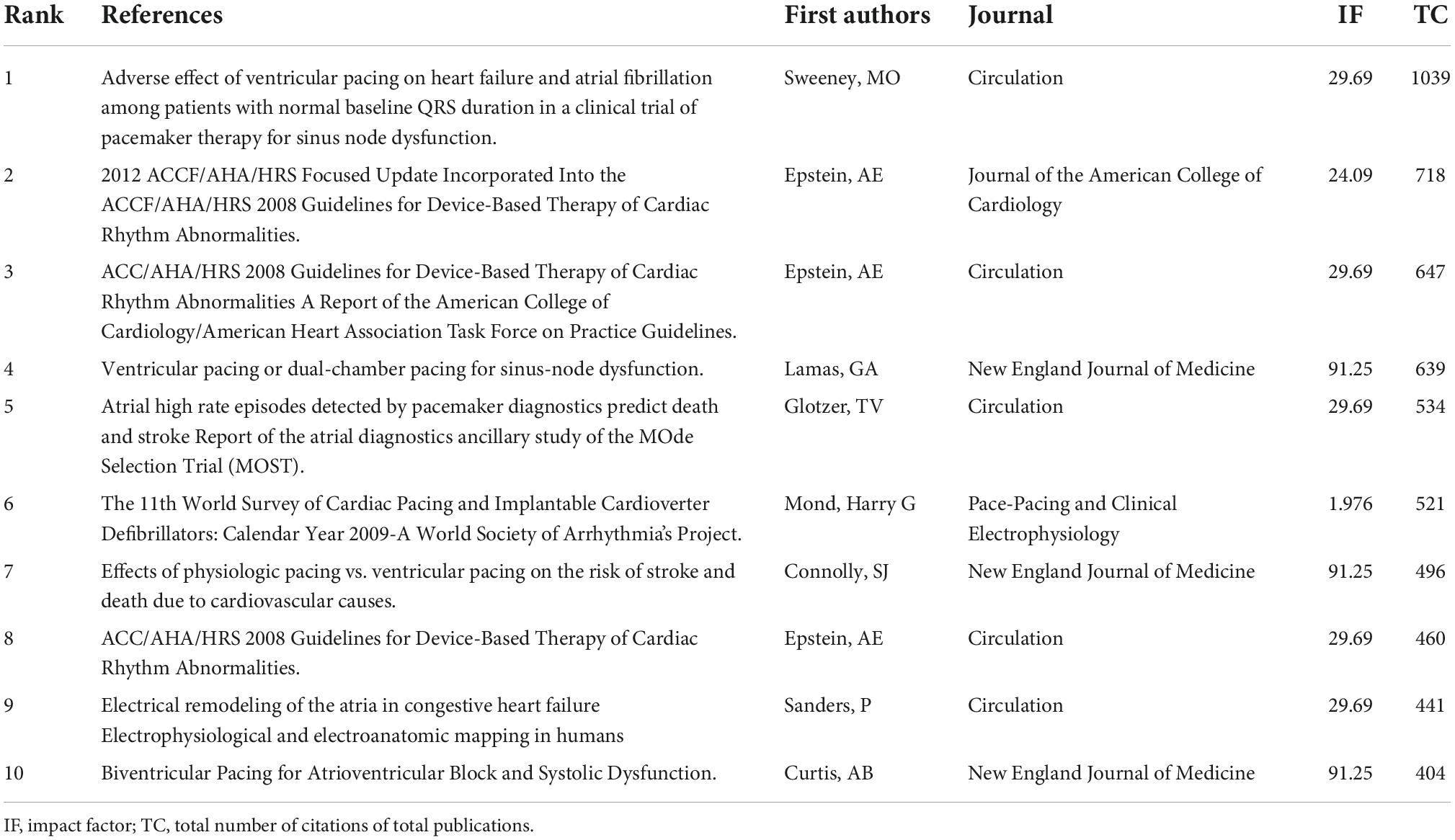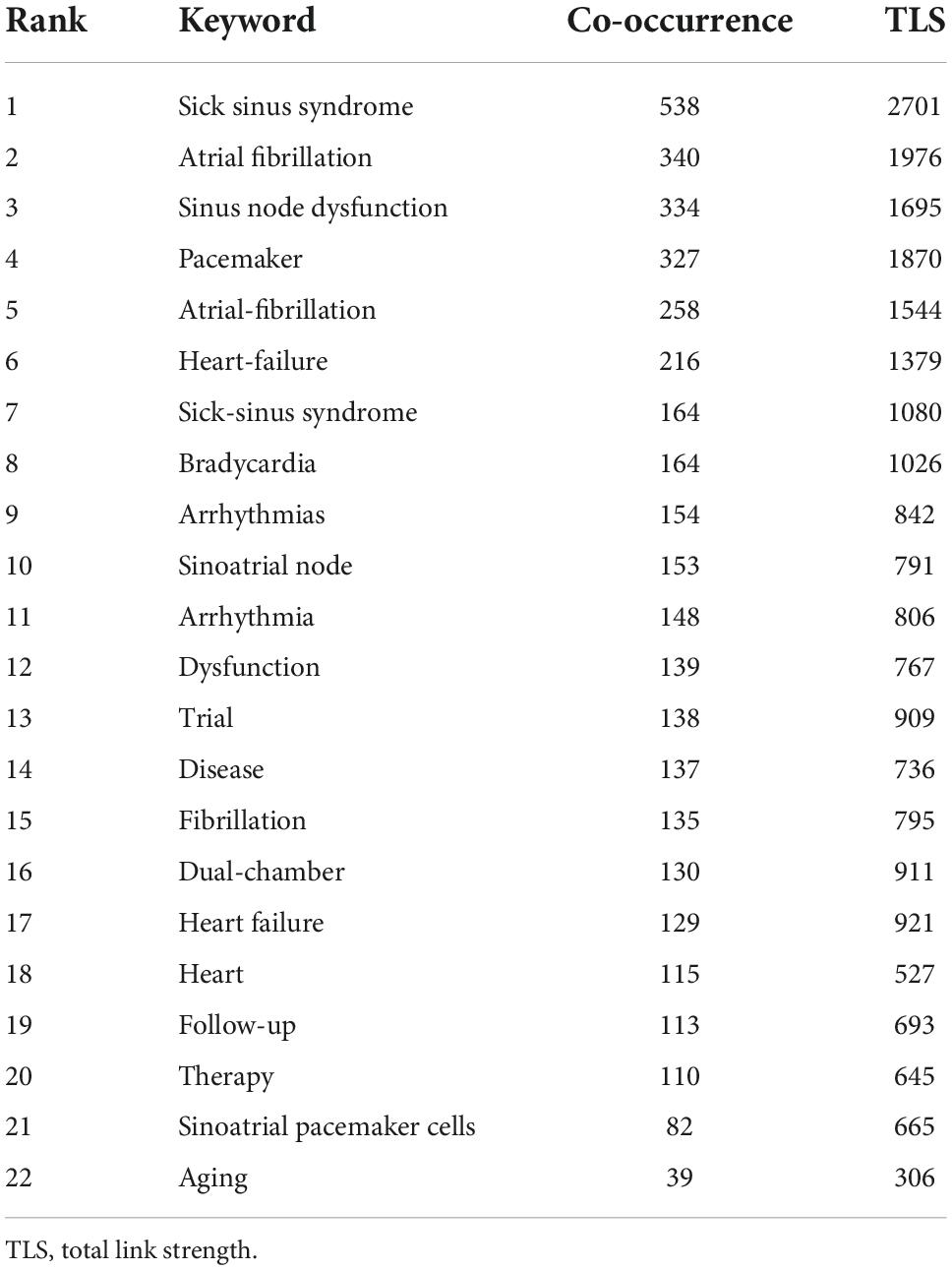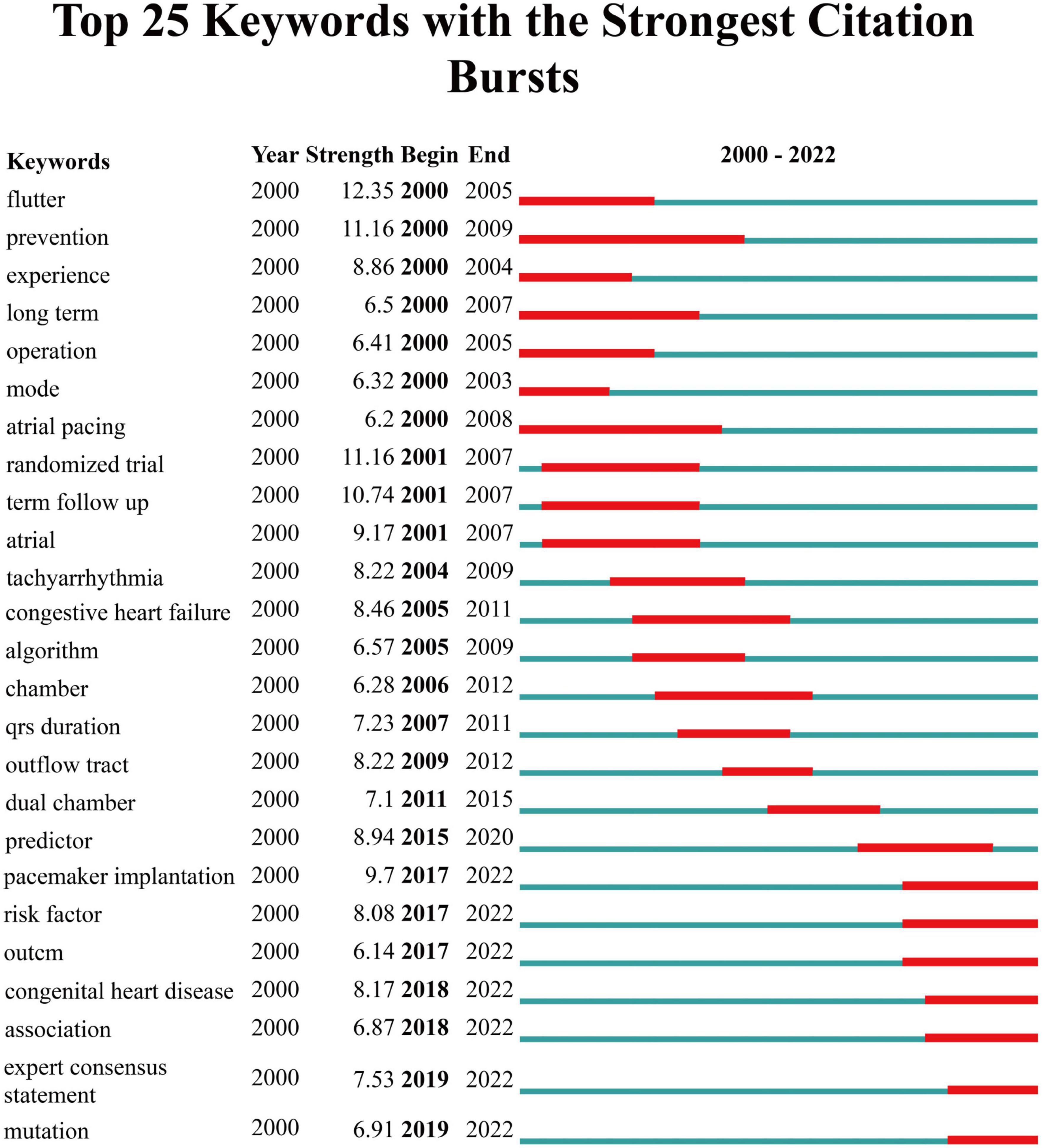- 1Department of Cardiovascular, Guang’anmen Hospital, China Academy of Chinese Medical Sciences, Beijing, China
- 2Department of Cardiovascular, Dongzhimen Hospital, Beijing University of Chinese Medicine, Beijing, China
Sick sinus syndrome (SSS) is a refractory arrhythmia disease caused by the pathological changes of sinoatrial node and its adjacent tissues. 2,251 publications related to SSS were retrieved from Web of Science database from 2000 to 2022 and analyzed by using VOS viewer and CiteSpace software. The results showed the United States dominated the field, followed by Japan, Germany, and China. SSS was closely related to risk factors such as atrial fibrillation and aging. Sick sinus syndrome, atrial fibrillation and sinus node dysfunction were the top three keywords that had the strongest correlation with the study. Pacemaker implantation, differentiation and mutation are research hotspots currently. Clinical studies on SSS found that sick sinus syndrome, atrial fibrillation, and pacemakers were the top three keywords that had the largest nodes and the highest frequency. In the field of basic applied research and basic research, atrial fibrillation and pacemaker cells were the focus of research. In conclusion, bibliometric analysis provided valuable information for the prevention, treatment and future research trends of SSS.
Introduction
Sick sinus syndrome (SSS) is a group of syndromes in which the pacing and efferent functions of the sinoatrial node (SAN) are impaired due to organic changes in the SAN and its surrounding tissues, resulting in chronic arrhythmias with insufficient blood supply to the heart, brain, kidneys and other organs (1). SSS is usually diagnosed by the patient’s signs and symptoms examination as well as electrocardiogram examination. SSS is asymptomatic or mildly symptomatic in the early stages, and some patients with SSS are detected on physical examination. Manifestations of SSS mainly include sinus bradycardia, ectopic atrial bradycardia, sinus node outlet block, sinus arrest, sinus node arrest, brady-tachy arrhythmia syndrome, chronotropic insufficiency, and rhythmic separation, etc. (2). Supraventricular tachycardia occurs intermittently in about 50% of patients with SSS, which is known as brady-tachy arrhythmia syndrome, a typical clinical manifestation of SSS (3). Although SSS was closely associated with atrial fibrillation, the exact underlying pathogenesis remains unclear (4). In a human and animal models of atrial fibrillation, atrial fibrillation induced remodeling of the right and left atria (including the sinus node), leading to atrial fibrosis, impaired calcium channels, and abnormal gene expression in patients with SSS, which exacerbates sinus node dysfunction and the progression of atrial fibrillation (5–7). Other studies suggested that aging and myocardial fibrosis may be a common pathogenesis of SSS and atrial fibrillation, but the research could not account for all cases of SSS and more in-depth pathogenesis needs further research (8).
Impaired sinus node pacing with sinus bradycardia or sinus arrest, where the heart has difficulty compensating for the slowed or stopped heart rate with a reduction in cardiac output per boom, may result in signs and symptoms of cardiac insufficiency (9). The symptoms of SSS patients were gradually aggravated from mild fatigue, insomnia, memory loss, transient vertigo and syncope, which showed a positive correlation between the degree of organ ischemia and the duration of cardiac arrest (10). The DANPACE study identified the incidence, predictors and prognostic significance of syncope in 1415 patients with SSS, and after a mean follow-up of 5.4 years the results found a higher mortality rate in patients with SSS who experienced syncope (11). Epidemiological studies suggested that the age of onset of SSS is between the ages of 20 and 90 with an increasing incidence with age (12). SSS was most prevalent in the elderly, and its 5-year survival rate was 62−65%, and the incidence of embolism was 15% (13). The incidence of SSS has been increasing in United States since 2012, with more than 75,000 people suffering from SSS each year. Approximately, 1 in 600 patients with cardiovascular disease over 65 years old was a SSS patient (14). It was estimated that by 2060 there will be more than 172,000 new cases of SSS in the United States each year (15). Until now, artificial pacemaker implantation had been recognized as the most effective treatment for SSS, with more than 50% of surgical pacemaker implantations surgery worldwide are performed for SSS patients (16). However, there are still many patients for whom a pacemaker is not suitable and there is no evidence that many patients do have a reduction of mortality after implanting artificial pacemaker (17). In recent years, in order to overcome the drawbacks of traditional artificial pacemakers, more and more researchers have focused on biological pacemakers, and biological pacing treatment is becoming a research hotspot (18).
Bibliometrics had been recognized by researchers since 1958. It is a useful method to study the distribution of literature, quantitative relationships and regular changes by using mathematics, statistics and other measurement methods, which is often applied in libraries and information science schools (19). Scientific research often involves many interdisciplinary disciplines, and cross-nodes of related research fields can be found through bibliometrics analysis. The application of bibliometrics to the medical field helps researchers to quantitatively analyze the current status of research, publication trends, countries/regions, institutions, researchers, future research hotspots of a disease at the macro and micro levels. Bibliometrics was widely used for visualization of the development of research on a disease in recent years (20). Bibliometrics can provide useful information for the world’s scientific research and clinical workers, and also provide reliable standards for the standardization of academic quality and reference information for international academic exchange and cooperation. Currently, bibliometrics has been widely used in medical research fields, such as chronic heart failure, cardio-oncology, pulmonary hypertension, cardiomyopathy and cardiorenal syndrome (21).
Therefore, we collected qualitative and quantitative data of publications on SSS from 2000 to 2022 in the Web of Science core collection database (WoSCC, Clarivate Analytics, Philadelphia, PA, United States)1 and identified the most prolific countries, institutions, authors, journals, keywords, and research hotspots in the fields by using VOS viewer and CiteSpace. The objective of our study was to provide a comprehensive bibliometric analysis of SSS for the past 22 years worldwide, hoping to help scholars with the current status, research hotspots, and the future trends of SSS research. We hope that this study will have a positive effect on the development of research on SSS and provide new insight for researchers and clinicians working on SSS study.
Materials and methods
Data source and search strategy
Web of Science core collection, a web-based multidisciplinary literature database built by Thomson Reuters using the open environment of the Internet, was used as the data source for this study, and it was considered to be one of the most influential and authoritative databases in the world. The search parameters were set as follows: Subject term: [Sick Sinus Syndrome] or [Sinus Node Dysfunction]; Time span: [from 2000 to 2022]; Type of literature: [articles and reviews]; Citation indexes: [SCI-Expanded]; Language selection: [English]. All data searched were exported and saved in plain text format, including title, author, keywords, source, abstract and references. The search covered the period 01 January 2000 to 12 May 2022. The retrieval was conducted in 1 day (12 May 2022).
Data retrieval and analysis
All research data were retrieved from WoSCC independently by two researchers (Yutong Zhou and Yong Zhao) to ensure the credibility, and imported into Microsoft Excel for data processing. The retrieved data were exported in plain text form. Firstly, we extracted indicators such as number of annual publications, countries/regions, source journals, institutions, authors, keywords, and frequency of citations from the retrieved data, and then analyzed these indicators statistically. To assess the scientific quality of the retrieved data, the impact factor (IF) and journal citation reports (JCR) categories of publications were extracted, and the IF and categories published by the JCR for 2021 were used for analysis in this study. IF is an evaluation metric for journals published by the JCR that represents the average number of citations per paper published in the journal in the last two years, which is an important indicator reflecting the academic level of the journal and the quality of the paper. JCR assigned each journal to its corresponding IF and ranks them by specific fields (Q1, Q2, Q3, and Q4). In addition, another indicator applied in this study was the h-index. It is also known as the h-factor, which is a new method to evaluate academic achievement. h stands for “high citations,” represented the number of h articles published by a researcher with each article receives at least h citations. For example, a researcher’s h-index is 20, which means that he has published at least 20 papers that have each been cited at least 20 times. Therefore, the h-index reflects a researcher’s scholarly status accurately. The higher a researcher’s h-index, the more influential his paper is. Therefore, it was often considered as a useful indicator to evaluate the scientific output and influence of a researcher, country or institution.
Visualized analysis
Network and density visualization maps were created by using VOS viewer version 1.6.18 (Technical Studies, Leiden University, Leiden, Netherlands) with nodes representing information such as times, countries/regions, institutions, authors, keywords, and cited references. The size of the nodes was determined by the weight of the elements, such as the number of publications, the number of citations or the frequency of occurrence. Each node was given a color, with the same color representing the same cluster. The links between nodes indicated the relevance of the elements to each other. The thickness of the links indicates the strength of the links, the thicker the link, the stronger the link. Total link strength (TLS) was adopted to quantitatively evaluate the links. Similar analysis was conducted to create visual maps of highly cited publications and the countries/regions, organizations, journals and authors of publications in each period to graph the evolution of these elements. CiteSpace V (Version 6.1 R2, Drexel University, United States) was employed to (i) create a visual map of the cited reference network from a time zone view, and (ii) detect a burst analysis of co-occurrence keywords. The parameters of CiteSpace were set as follows: time slice (2000−2022), year per slice (1), item source (all selected), node type (1 at a time), selection criteria (50), pruning (Pathfinder), visualization (cluster view static, showing the merged network). The detailed workflow for literature filtering and data analysis is shown in Figure 1A.
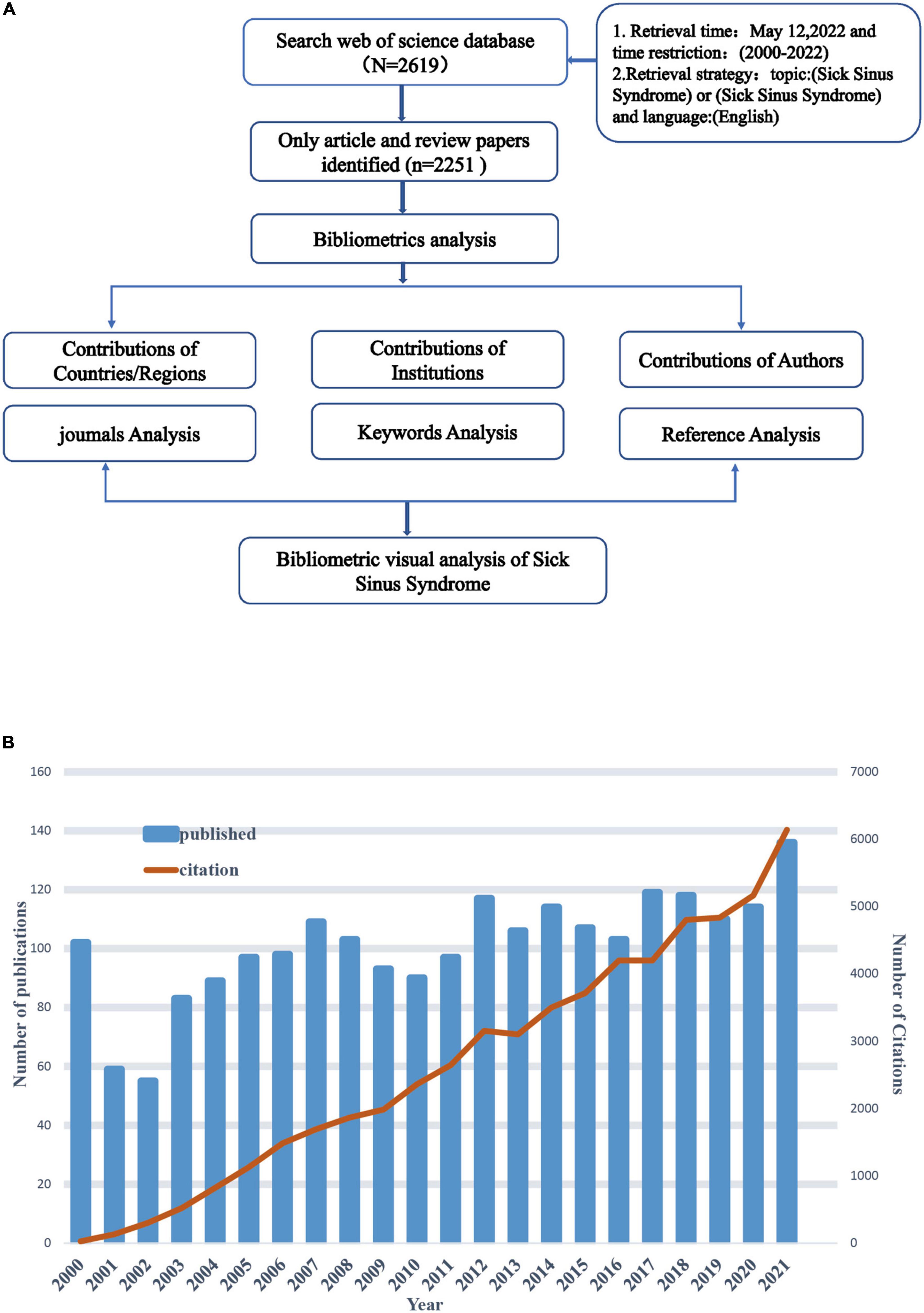
Figure 1. (A) Flow chart of literature retrieval of sick sinus syndrome (SSS) research. (B) Global trend chart of annual publications and citations related to SSS research from 2000 to 2022.
Results
Annual publication outputs and citation trend
The 2,619 publications were retrieved from WoSCC after the Subject terms were set as “Sick Sinus Syndrome” or “Sinus Node Dysfunction,” as well as the time span was set as “from 01 January 2000 to 12 May 2022.” A total of 2,251 publications of “articles” or “reviews” met the inclusion criteria for bibliometric analysis eliminating 176 conference abstracts, 135 editorial materials, 49 letters and 8 others. We can find from the chart of literature publications and citations that the horizontal coordinate represents the year, the left vertical coordinate represents the number of publications, and the right vertical coordinate represents the frequency of citations (Figure 1B). As can be seen from Figure 1B, the total citation frequency of publications were 59,399 times (49820 times, excluding self-citation), with an average of 2582.57 citations per year and 26.39 citations per paper. H-index was 105.
During 2000 to 2022, the annual number of publications (articles and reviews) was in the range of 30−70 with an upward trend overall, and the annual citation frequency of publications increased over time (Figure 1B). In terms of different stages: (i) 2000−2002: In this stage, the number of published papers per year showed a clear downward trend, and was reduced by half in 2002 compared with the number of papers published in 2000. The citations were in the range of 10−96, with a constant growth rate; (ii) 2002−2007: The number of papers published in this time period increased from 55 to 109 with a steady growth trend, followed by a short-term decline during 2008−2011. The growth rate of citations remained the same. (iii) 2010−2015: During which the number of publications on SSS in this time period showed a steady growth trend, followed by another short-term decline during 2015−2016. The growth rate of citations remained the same. (iv) 2016−2022: The number of publications keeps growing from 2016 to 2018, and then there was a slightly decrease in 2019. The number of papers continued to grow in the following 2 years and reached a growth peak in 2021. The growth rate of citations remained the same. Significantly, the output of publications in 2021 was 136, and had been cited for up to 6,138 times.
Contributions of countries/regions
The 2,251 total publications (TP) were published by researchers in 77 countries/regions (Figure 2A). The top 10 countries accounted for 95.454% of the TP worldwide from 2000 to 2022 (Table 1). Among the top 10 countries in terms of TP, United States ranked first in terms of publications with 657 publications accounting for 29.14%, which was more than two times higher than Japan (271, 12.03%), who ranked second, and followed by Germany (222, 9.81%). For United States, both the total number of citations of total publications (TC = 25915) and the total link strength (TLS = 542392) were the highest. The other 7 countries in terms of TP are ranked as follows: China (214, 9.51%), Italy (189, 8.40%), England (169, 7.46%), France (143, 6.35%), Netherlands (139, 5.55%), Canada (125, 3.15%), and South Korea (71, 3.15%).
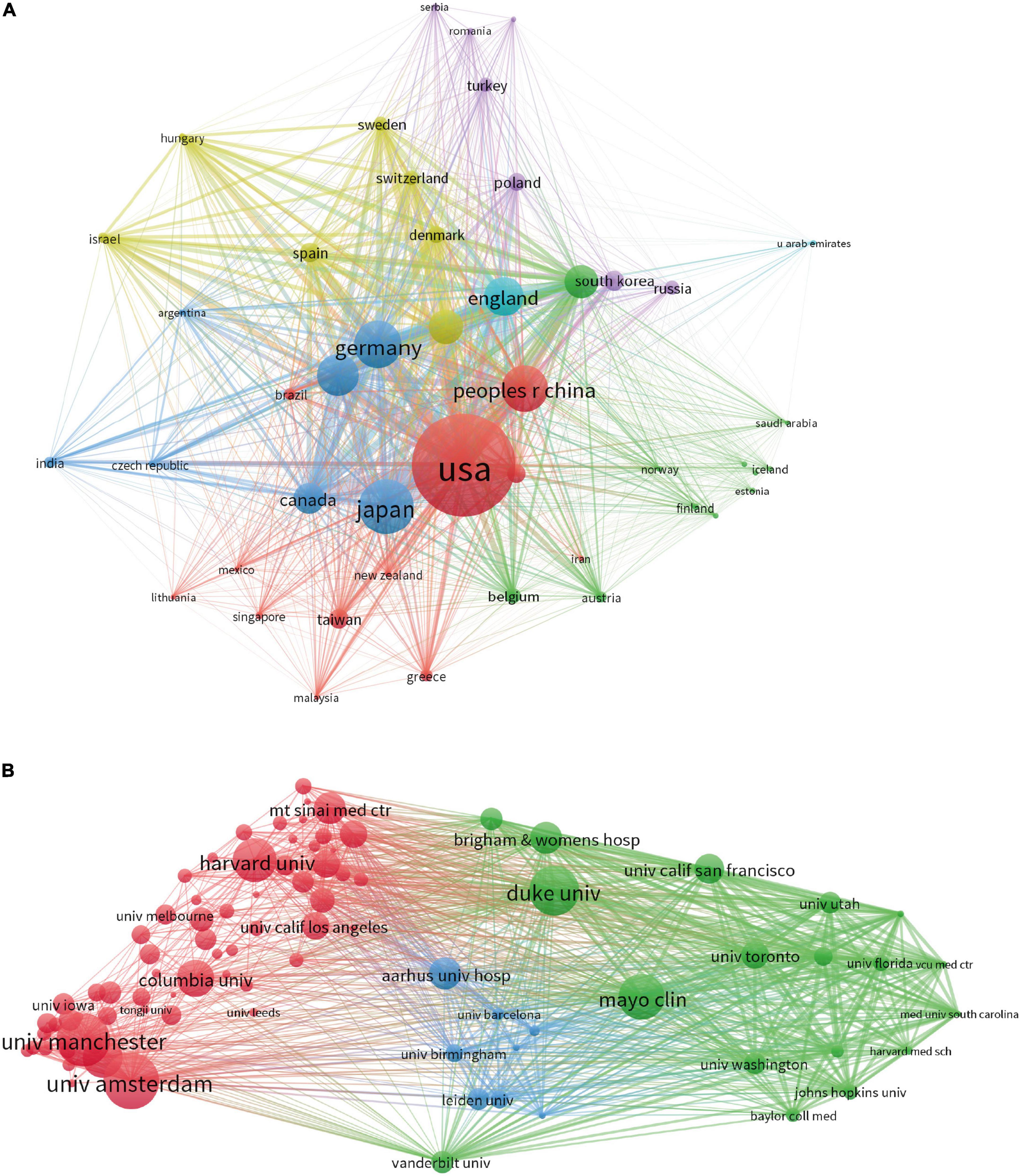
Figure 2. (A) Network map of Country/Region analysis based on VOS viewer. (B) Network map of Institutions analysis based on VOS viewer.
Contributions of institutions
A total of 2,251 papers (TP) were contributed by 2,545 institutions (Figure 2B). Among the top ten prolific institutions presented in Table 2, seven institutions were from United States, while the other three institutions were from Netherlands, England, and Denmark. University of Amsterdam (TP = 47) was the most productive institution, followed by University of Manchester (TP = 45), Duke University (TP = 42), Mayo Clinic (TP = 39), Harvard University (TP = 37), Ohio State University (TP = 34), Columbia University (TP = 31), Aarhus University (TP = 27), Brigham Women S Hospital (TP = 27), Mount Sinai Medical Center (TP = 25). The top three institutions for total publications in terms of total citations and total contact strength were Harvard University (TC = 4004, TLS = 155), Duke University (TC = 3869, TLS = 226), and Brigham Women’s Hospital (TC = 3363, TLS = 154).
Authors and co-cited authors
A total of 2,251 papers were published by 10,746 researchers (Figures 3A,B). The top 10 most prolific authors and co-cited authors were presented in Table 3. Ellenbogen KA from the University of Liverpool ranked first with 35 publications (1.55%), followed by Lamas GA from Columbia University with 31 publications (1.38%), Nielsen JC from Aarhus University with 31 publications (1.38%), Boriani G from Universita di Modena e Reggio Emilia with 28 publications (1.24%), Mohler PJ from Ohio State University with 28 publications (1.24%), Dobrzynski H from Jagiellonian University with 25 publications (1.11%), Boyett MR from University of Liverpool with 22 publications (0.98%), Joung B from Yonsei University Health System with 21 publications (0.93%), Lee KL with 21 publications (0.93%), Sweeney MO from Truman Med Ctr with 21 publications (0.93%).
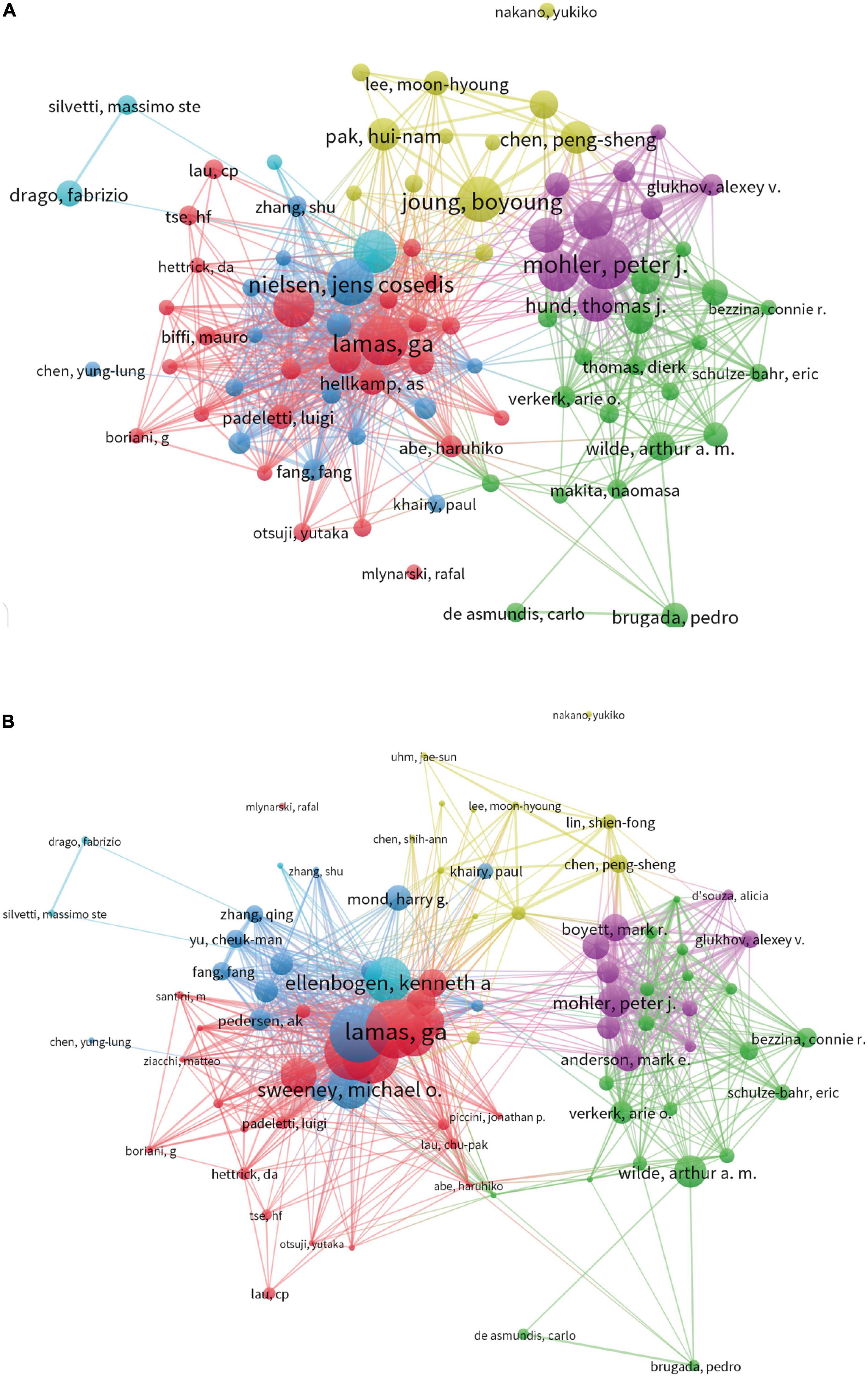
Figure 3. (A) Network map of authors analysis based on VOS viewer. (B) Network map of citation authors analysis based on VOS viewer.
Journals and co-cited journals
A total of 2,251 papers (TP) were published in 542 different journals (Figures 4A,B). Table 4 presented the top 10 most published journals by name, volume, IF, JCR division, and publisher. Pace Pacing and Clinical Electrophysiology, the most prolific journal in terms of TP, was ranked first with 190 articles, accounting for approximately 32% of the TP. followed by Europace (133 articles, 5.91%, Q2), Journal of Cardiovascular Electrophysiology (82 articles, 3.64%, Q3), Heart Rhythm (71 articles, 3.15%, Q1), Circulation (54 articles, 2.4%, Q1), Journal of Interventional Cardiac Electrophysiology (51 articles, 2.27%, Q4), International Journal of Cardiology (41 articles, 1.82%, Q2), Circulation Journal (39 articles, 1.73%, Q3), Journal of the American College of Cardiology (37 articles, 1.64%, Q1), and Annals of Thoracic Surgery (36 articles, 1.60%, Q2).
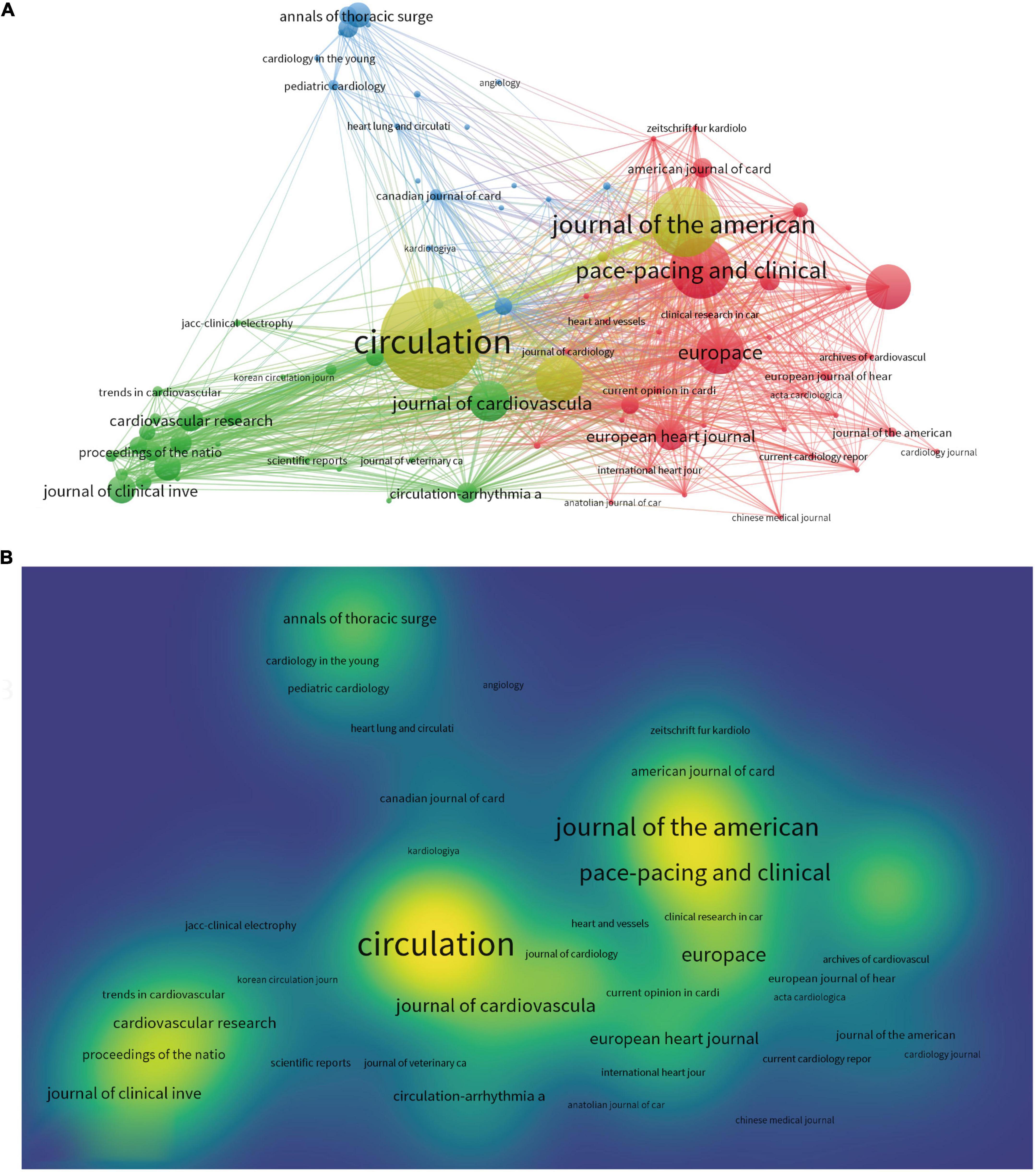
Figure 4. (A) Network map of journals analysis based on VOS viewer. (B) Density map of journals analysis based on VOS viewer.
References and co-cited references
As shown in Table 5, a total of 44238 references were cited in this study, which were mainly related to SSS, atrial fibrillation, heart failure, pacemaker implantation, differentiation, and molecular mechanisms (Table 5). The ten most-cited references were analyzed to reflect the current research status and research hotspots with a maximum IF of 91.25. Among the top 10 references, 9/10 were published in high impact journals including three were published in New England Journal of Medicine, five were published in Circulation, and one was published in Journal of the American College of Cardiology. Most of the papers were published in the field of “clinical trials, medical guidelines and basic experiments,” which may reflect that the research on SSS were mainly focus on clinical, therapeutic management and pathogenesis. The most cited article was a 6-year term prospective randomized controlled clinical trial on pacemaker therapy for sinus node dysfunction published in Circulation (Table 5). The article indicated that dual chamber pacing (DDDR) can better maintain AV synchronization compared with ventricular pacing in sinus node dysfunction (VVIR), consequently reducing the risk of hospitalization for heart failure and atrial fibrillation in SND patients (22). The second and third most cited article was a clinical practice guideline for device-based therapy of cardiac rhythm abnormalities published in the New England Journal of Medicine (23) and Circulation (24).
Keyword analysis
We used VOS viewer to create a web map of keywords and the statistics showed that 6,447 keywords were extracted from 2,251 papers, of which 6 keywords appeared more than 200 times, 25 keywords appeared exceeding 100 times, and 74 keywords appeared more than 50 times (Figure 5A). Among the top 22 keywords listed in Table 6, the most frequently occurring keyword was sick sinus syndrome (538, TLS = 348), followed by atrial fibrillation (340, TLS = 307), sinus node dysfunction (334, TLS = 236), pacemaker (327, TLS = 311), atrial-fibrillation (258, TLS = 260), heart failure (216, TLS = 224), sinoatrial pacemaker cells (82, TLS 665) and aging (39, TLS 306). We analyzed the keyword co-linearity, clustering and density distribution, and used CiteSpace to plot the strongest citation bursts Figure 5B. From Figure 5A and Table 6, it can be seen that the three keywords sick sinus syndrome, atrial fibrillation and sinus node dysfunction had the largest nodes, the highest density and the highest frequency, and were the most relevant to the study of SSS, which is consistent with the topic of our study. Pacemaker implantation, heart-failure, differentiation and mutation were research hotspots currently (Figure 6). Notably, although the total amount of publications on the differentiation and mutation of SSS were relatively limited, it can be seen from the keyword bursts figure that the field of biological pacemaker had gradually become a research hotspot in recent years.
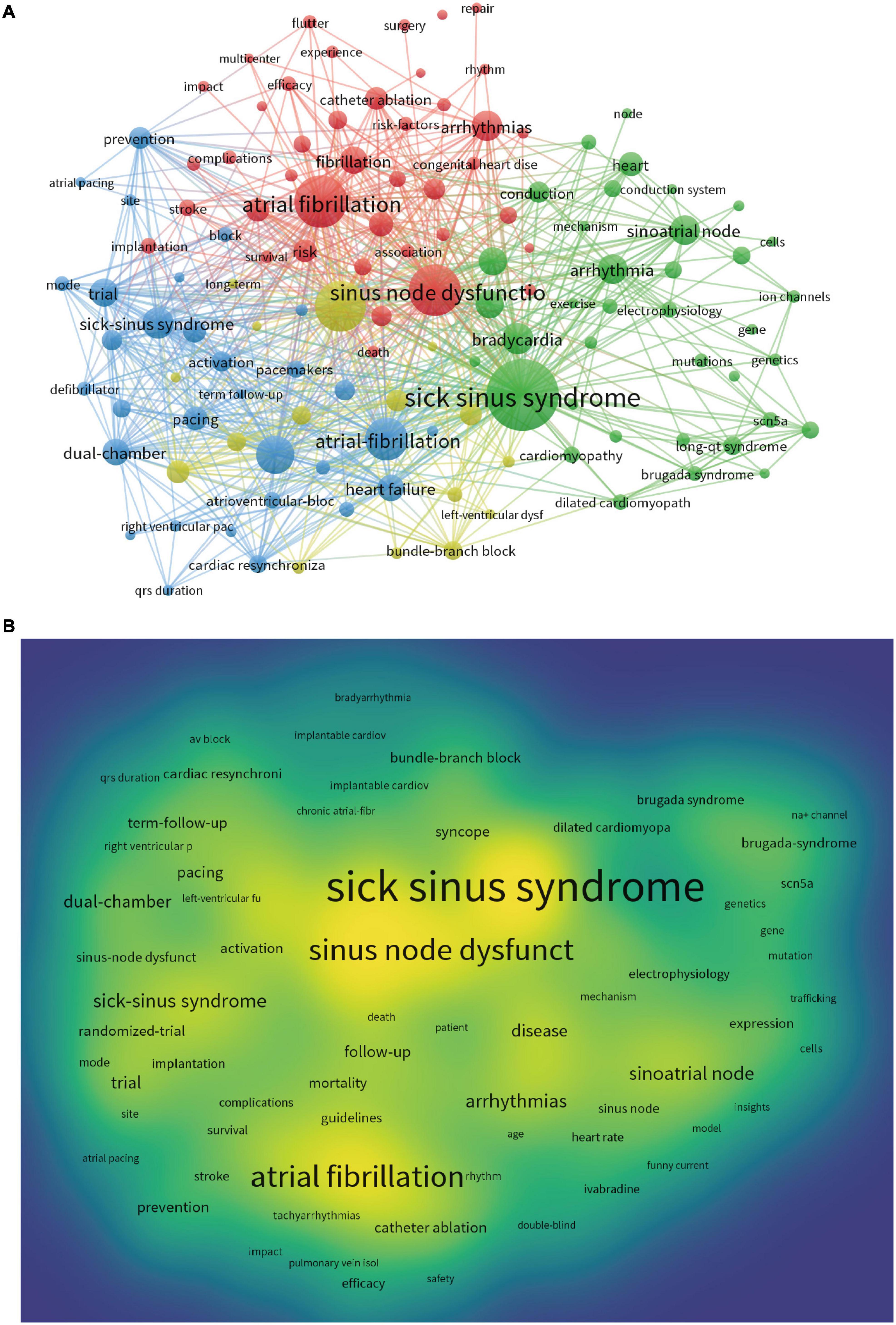
Figure 5. (A) Network map of keywords analysis based on VOS viewer. (B) Density map of keywords analysis based on VOS viewer.
Pacemaker cells isolated from the sinoatrial node
Studying on pacemaker cells isolated from SAN is highly important for the research of SSS. Therefore, we conducted a secondary screening of the retrieved literature on SSS and identified 906 research papers (the type of literature was all articles) related to pacemaker cells isolated from SAN for statistical analysis and network diagrams production. As can be seen from the Figure 7A, most of the current research related to pacemaker cells isolated from the SAN was mainly basic research. The research hotspots were mainly focused on sinoatrial node, rabbit sinoatrial node, pacemaker activity, ryanodine receptor, ventricular myocytes, channels, ion channels, sarcoplasmic reticulum, funny current, calcium, electrical activity, etc. From the results of the statistical analysis, we can see that researchers are keen to investigate the principles of pacemaker cell operation and the mechanisms of lesions that cause pathological sinus node syndrome. However, we have not observed widespread clinical application of research results on pacemaker cells isolated from the SAN.
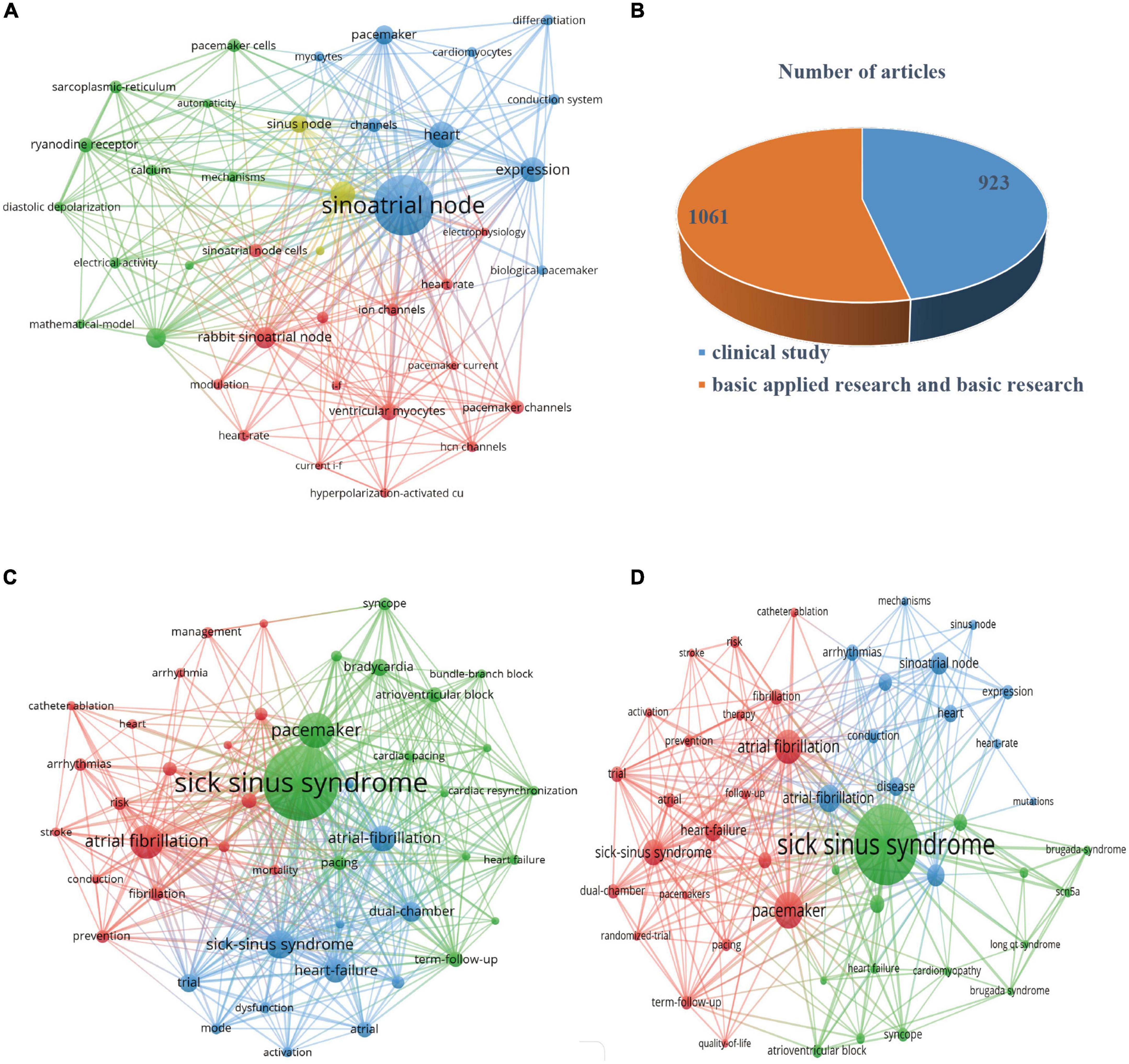
Figure 7. (A) Network map of pacemaker cells isolated from the sinoatrial node based on VOS viewer. (B) Numbers of articles of clinical research, basic applied research and basic research on SSS. (C) Network map of clinical research on SSS based on VOS viewer. (D) Network map of basic applied research and basic research on SSS based on VOS viewer.
Clinical, basic applied research and basic research of sick sinus syndrome
We conducted a secondary screening of the retrieved literature on SSS, and 1984 research papers were retrieved after the type of literature were set as “articles,” and the type of study were set as “clinical research” (923 articles) or “basic applied research and basic research” (1061 articles), (Figure 7B). We used VOS viewer to create a web map for statistical analysis (Figure 7C). And the statistics showed that the most frequently occurring keyword in clinical research was sick sinus syndrome (384, TLS = 2756), followed by atrial fibrillation (154, TLS = 1109), bradycardia (72, TLS = 924), term-follow-up (62, TLS = 778), and dual-chamber pacemaker (85, TLS = 773). As can be seen from Figure 7C, the pathogenesis of SSS was closely associated with atrial fibrillation and a lot of clinical trials have been conducted by researchers worldwide to study the relationship between atrial fibrillation and SSS. The most frequently occurring keyword in basic applied research and basic research was sick sinus syndrome (391, TLS = 1089), followed by pacemaker cells (15, TLS = 538), atrial fibrillation (149, TLS = 524). In the fields of basic applied research and basic research, pacemaker cells were the focus of research, involving studies on calcium clocks, ion currents, membrane clocks, and pacemaker-like cells (Figure 7D).
Atrial fibrillation and sick sinus syndrome
We used VOS viewer to create a web map for the analysis of the correlation between SSS and atrial fibrillation (Figures 8B,C). We analyzed the number of publications, keyword co-linearity, clustering, references and co-cited references, and the statistics showed that 4,957 keywords were extracted from 1,627 papers, of which 4 keywords appeared more than 200 times, 16 keywords appeared exceeding 100 times, and 50 keywords appeared more than 50 times (Figures 8A–C). The most frequently occurring keyword was sick sinus syndrome (545, TLS = 1584), followed by atrial fibrillation (341, TLS = 1240), pacemaker (268, TLS = 1017), atrial-fibrillation (259, TLS = 908), heart failure (186, TLS = 826) and sinus node dysfunction (185, TLS = 679). From Figure 8B, it can be seen that the three keywords sick sinus syndrome, atrial fibrillation and pacemaker had the largest nodes, the highest density and the highest frequency. In addition, we analyzed the references and co-cited references of SSS and atrial fibrillation (Figure 8C). The most cited article was a review about the pathogenesis of atrial fibrillation published in Nature, in which the authors concluded that there is a clinical association between abnormal sinus node function and atrial fibrillation and that sinus node dysfunction and atrial fibrillation interact with each other (25). The second most cited article was a clinical trial paper published in Circulation, which found that ventricular desynchronization caused by ventricular pacing may increase the risk of hospitalization for heart failure and atrial fibrillation (22). The third one was a clinical guideline on the device therapy of cardiac rhythm abnormalities published in 2012 in the New England Journal of Medicine (23).
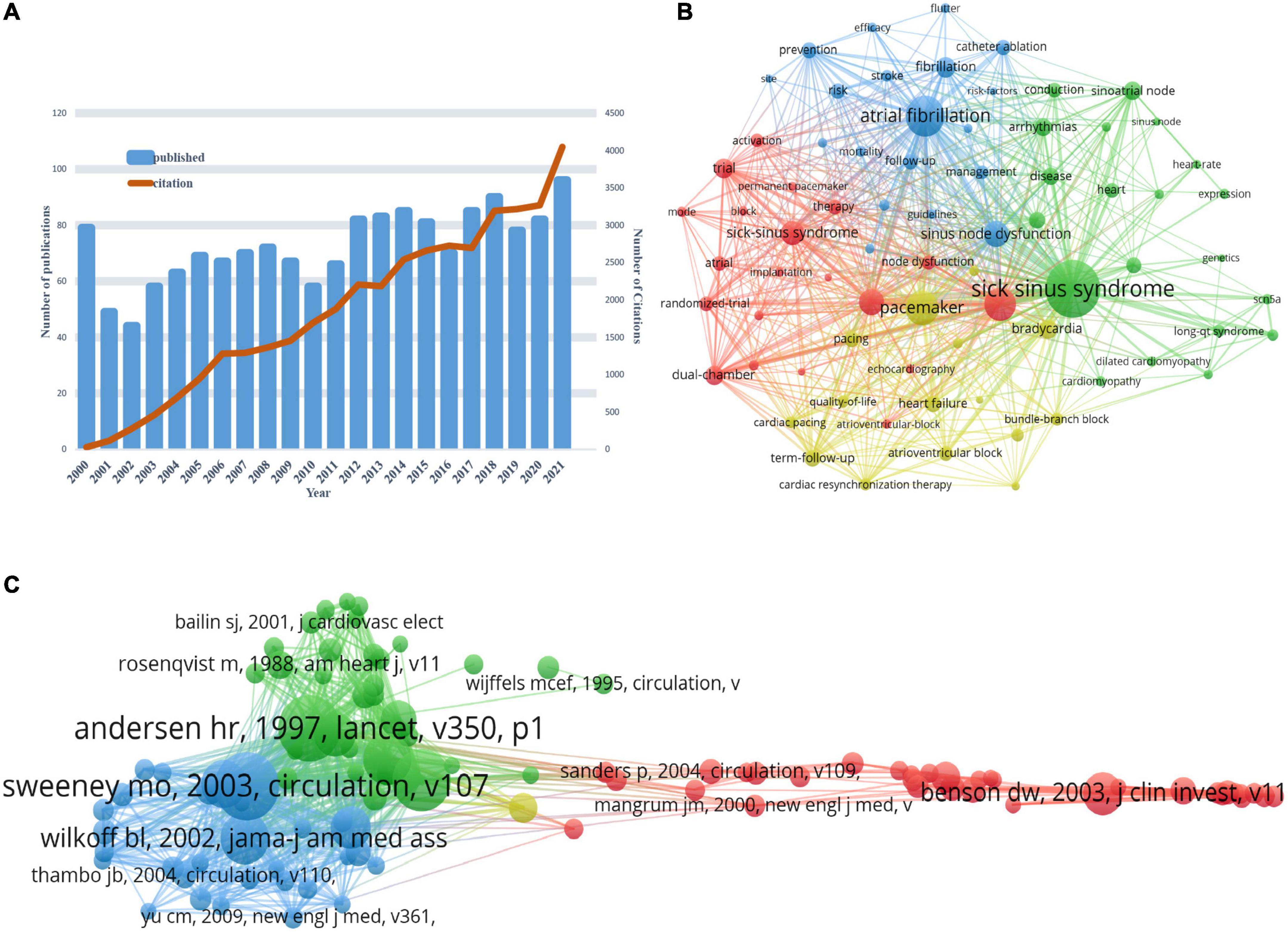
Figure 8. (A) Global trend chart of annual publications and citations of the study on the correlation between SSS and atrial fibrillation from 2000 to 2022. (B) Network map of the keywords of SSS and atrial fibrillation based on VOS viewer. (C) Network map of the references of SSS and atrial fibrillation based on VOS viewer.
Discussion
Analysis of the current status of research
In terms of countries/regions, a country’s scientific research capacity was positively correlated with its economic power. The number of publications on SSS in United States were much more than that of other countries in the world, which means the United States was a world leader in this field. European countries were also stronger in the field of SSS study, with countries such as Germany, England, Italy, France, and Netherlands ranking in the top positions. Among Asian countries, Japan, China, and South Korea were relatively strong in SSS research. Countries in Africa and South America had fewer scientific outputs and were weaker in the field of SSS research. From the view of institutions, the institutions with the strongest research ability on SSS worldwide were University of Amsterdam, University of Manchester and Duke University. University of Amsterdam, founded in 1632, was one of the world’s leading research universities located in Amsterdam, with six Nobel Prize winners and five Dutch Prime Ministers produced here. The University of Manchester, a comprehensive university founded in 1824, was one of the top 50 universities in the world, with 25 Nobel Prize winners totally in the history. Duke University, founded in 1838, was one of the world’s leading research universities in the southern United States. Duke University was equally well known with MIT and the University of Pennsylvania.
Keywords was a significant indicator for reflecting the content of a study, and the frequency of a keyword may show the number of studies in a scientific field. In the keyword burst analysis from 2,251 publications on SSS, the frequency of occurrence of sick sinus syndrome, atrial fibrillation, sinus node dysfunction, and pacemaker were the highest, followed by pacemaker implantation, risk factors, heart disease, differentiation, and mutation in the last 3 years. Which indicated that the research on SSS was gradually intensifying, and more and more researchers had paid great attention to the risk factors and treatments for SSS (2). Up to date, a lot of scholars were devoting themselves to studying pacemakers, such as permanent pacemakers, pacemaker implantation methods, and complications management (26). And some scholars focused on the study of biological pacemakers, which may be a research hotspot on SSS in the future (27).
Risk factors of sick sinus syndrome
The pathogenesis of SSS is related to many risk factors (28). A17-year term prospective study by Kristensen team found that the incidence of SSS increased with age, and the other risk factors mainly included atrial fibrillation, heart failure, obesity, NT-proBNP, hypertensive heart disease, gene mutations, and autonomic neuropathy, etc. (15, 29).
Aging
The function of the sinus node decreased with age, leading to an increase in the incidence of sinus node dysfunction and the number of pacemaker implantation in the elderly (15). Alghamdi et al. (30) assessed the potential mechanisms of aging and sinus node dysfunction, and found that aging-induced ion channel remodeling and abnormal Ca2+ handling produced bradycardia effects. Jones et al. (31) reported progressive loss of Cav1.2 protein in SAN tissues of aged guinea pig accompanied by reduced spontaneous activity. Zhang et al. (32) found upregulation of miR-1976 expression in plasma of age-related SSS patients. Interestingly, they further demonstrated experimentally that microRNA-1976 induces degeneration of the sinoatrial node by targeting and regulating Ca1.2 and Ca1.3 ion channels in rabbit sinoatrial node cells.
Atrial fibrillation
Atrial fibrillation and SSS often coexist, and they induce and perpetuate each other (33). More than 50% of patients with SSS may develop a brady-tachy arrhythmia syndrome, with tachyarrhythmias, most commonly atrial fibrillation and atrial flutter, leading to an increased risk of embolism and stroke (34). And anticoagulation therapy had been shown to be beneficial to reduce the risk of embolism and stroke (35). In addition, secondary sinus node dysfunction was associated with atrial tachyarrhythmias and atrial fibrillation. The incidence of sinus node dysfunction increased to 45% in patients with atrial fibrillation over 10 years or more (36). Pastore et al. (37) collected retrospective data from 313 patients implanted with dual-chamber pacemakers for sinus node dysfunction and found that the adoption of His bundle pacing reduced the risk of persistent atrial fibrillation in patients with sinus node dysfunction and long basal PR intervals.
Heart failure
Heart failure was a major risk factors for secondary sinus node dysfunction, the mechanism of which may be related to gene mutation in HCN4, a Na + /K + hyperpolarization-activated cyclic nucleotide-gated (HCN) channels that was a molecular marker of functional sinus node cell activity and played a key role in the pacemaker potential (38, 39). The HCN4 gene was closely related to various arrhythmias, and deletions or substitution mutations in exon bases of the HCN4 gene in patients with hereditary arrhythmias such as familial sinus bradycardia leading to alterations in the HCN4 channel protein, causing a significant reduction in the initiates the funny current and leading to a decrease in cardiac pacing function (40). Up-regulation of HCN4 gene expression in patients with acquired arrhythmias such as heart failure, cardiac hypertrophy, and atrial fibrillation increased the funny current and leaded to arrhythmias (28).
Others
The pathogenesis of SSS is associated with obesity, hypertensive heart disease, and autonomic neuropathy. Clapp et al. (41) found that obese patients with pacemaker placement were younger compared to non-obese patients with pacemaker implantation. Yanni et al. (42) found that obesity was associated with a function-dependent decrease in SAN and structural remodeling of the SAN, which includes SAN enlargement, SAN cells hypertrophy and extracellular matrix remodeling. Hypertensive heart disease was associated with sinus node dysfunction and reduced heart rate variability by a mechanism involving reduced responsiveness of SAN cells to angiotensin II agonists, which leads to sinus node dysfunction (43).
Treatment strategies for sick sinus syndrome
Electrophysiological monitoring for sick sinus syndrome
According to 2018 ACC/AHA/HRS guideline on the evaluation and management of patients with bradycardia and cardiac conduction delay clinical guidelines, prolonged ECG monitoring was recommended in patients with intermittent symptomatic bradycardia and conduction disturbances to correlate rhythm disorders with symptoms (44). A multi-centered study on the evaluation of syncope noted that extensive ECG abnormalities were associated with the increase of all-cause mortality at 1 year (45). It was appropriate for patients presenting with daily bradycardia and conduction disturbances to take 24−48 h ambulatory electrocardiogram monitoring (46). A study showed that when the heart rate comes within 40 bpm, the central blood pressure decreases, which means that the load on the target organs is lower, however, lower absolute central blood pressure values may be a sign of left ventricular dysfunction (47).
Drug treatment for sick sinus syndrome
Acute sinus node dysfunction was usually treated with medications or temporary transvenous or transesophageal pacing (48). Medications commonly used were (i) α/β agonists such as dopamine, epinephrine, and isoprenaline, which helped to increase the heart rate (49). However, dopamine and epinephrine may increase myocardial oxygen consumption, which were not suitable for SSS patients with ischemic cardiomyopathy (49). Isoprenaline was a non-selective beta agonist that could enhances sinus and atrioventricular node function. However, isoprenaline has the potential to predispose supraventricular tachycardia or beta receptor-dependent vasodilation, therefore it was usually used for acute sinus node dysfunction or electrophysiological assessment only (50). (ii) Muscarinic receptor inhibitors: Atropine was a muscarinic receptor inhibitor that was commonly used in the diagnostic valuation of sinus node dysfunction. Studies had shown an improvement in acute bradycardia and sinus node dysfunction with 0.5−2 mg doses of atropine (51). Atropine had been shown to be beneficial in SSS patients with combined hemodynamic instability, with minimal risk of worsening bradycardia, local ischemia or enhancing ventricular fibrillation (52). (iii) Adenosine receptor blockers: Aminophylline and theophylline extended-release tablets belonged to the methoxy anthracycline class and produced positive chronotropic action on the heart, probably mediated by inhibition of the inhibitory effect of adenosine on the sinoatrial node (53). (iv) Phosphodiesterase inhibitors: Cilostazol was used to prevent thrombosis. Several studies had shown that the drug had beneficial effects on heart rate in sinus node dysfunction patients with slow-fast syndrome, the mechanism of which may be related to an increase in sympathetic input due to systemic vasodilation and increased cAMP concentrations in sinus node pacemaker cells (54).
Electronic pacemaker implantation
Implanting electronic permanent pacemakers was the most effective treatment for reducing symptoms in SSS patients, and the number of pacemakers implanted was expected to double in the next 50 years (55). In a randomized study of symptomatic sinus node dysfunction patients who were randomized to an untreated group, an oral theophylline group, and a permanently paced group, the permanent pacemaker was superior in symptom control compared to the control group, despite the fact that theophylline increased resting heart rate (56). The ANSWER study, a prospective randomized single-blind controlled trial enrolling 650 patients at 43 study centers in Europe, evaluated the safety and efficacy of a conversion pacing mode conversion between single chamber atrial (AAI) pacing and dual chamber pacing (DDD) vs. a standard DDD pacing mode, and found a 51% reduction in the risk of death or hospitalization due to heart failure in patients with switching pacing modes after 3 years of follow-up (57). Temporary transvenous pacing can increase heartrate and improve symptoms in SSS patients with persistent hemodynamic instability and ineffective drug therapy (58). In patients with symptoms directly attributable to sinus node dysfunction, permanent pacing may increase the heart rate and improve symptoms of cerebral hypoperfusion caused by bradycardia (59).
Prospects for research development in sick sinus syndrome
The application of electronic pacemakers had improved the quality of life for many patients with SSS, but it still has problems with infection, post-cardiac injury syndrome, wire loss and limited electronic life (60). In addition, many patients were not suitable or unwilling to undergo permanent pacemaker implantation (61). These problems limited the electronic pacemaker as the most ideal treatment for SSS, and scientists began to look for a more ideal treatment, therefore, the biological pacemaker was born on demand under such a background (62). The biological pacemaker-built sinus node pacing-like cells that perform normal pacing functions in the heart mainly through the regulation of single gene, multiple gene and signaling pathway (63). Current studies have found that genes and signaling pathways involved in biological pacing include T box gene 3 (Tbx3), Tbx 18, Insulin-like growth factor-1(ISL-1), short state homeobox 2 (Shox2), NK2 homeobox 5, Wnt signaling pathway and HCN signaling pathway, etc. (64, 65). At present, there are extensive studies on the genes of Tbx family, including Tbx 1, Tbx 3, Tbx 5, and Tbx 18 (66). Different genotypes played different roles in the development of the heart. Among which, Tbx 3 was not involved in the morphological development of the SAN but played an important role in regulating the function of the SAN (67). Tbx 18 gene was mainly involved in the development of the head of the SAN (68). ISL-1 was one of the molecular markers of undifferentiated cardiac histocytes/heart cells in the second cardiac region, which can promote cardiac development and differentiation (69). Study had found that mouse embryos with the ISL-1 gene knocked out had cardiac arrest or severe cardiac malformations at day 9.5 (70).
The Wnt signaling pathway was divided into the classical Wnt signaling pathway and the non-classical Wnt signaling pathway, with the former playing a positive regulatory role in the development of the SAN (71). The classical Wnt signaling pathway functioned by activating a combination of maturation markers specific to pacemaker CMs (Shox2, ISL-1, Tbx18, HCN 4, and Tbx3), such as the induction of cardiac mesoderm formation and specific expansion of cardiac progenitor cells (72). Activation of classical Wnt signaling in human induced pluripotent stem cells derived from cardiac progenitor cells can initiate a gene regulatory program that inhibits NK2 homeobox 5 expression and promotes synergistic expression of Shox2, ISL-1, Tbx3, and Tbx18, thereby promoting the differentiation of cardiac progenitor cells into human pacemaker-like cardiomyocytes capable of pacing human heart (73, 74). However, most of the research so far had been focused on basic experiments, and the efficiency of targeted differentiation of pacemaker-like cells through regulation of genes and signaling pathways was relatively low (75). In addition, there is also a risk of causing inflammatory reactions and cytotoxicity in the organism, and more research are still needed in the future to overcome these problems and to provide a scientific basis for the study of biological pacing in humans and its gradual clinical application (68).
Conclusion
In this study, we summarized the current research status, countries/regions, authors, keywords, and research hotspots of SSS in the past 22 years with bibliometric visualization analysis, which revealed that the research for SSS were mainly focused on diagnostic, preventive, and clinical trials. Pacemaker implantation, atrial fibrillation, ischemic cardiomyopathy, differentiation, and gene mutations were potential research hotspots in recent years. In conclusion, bibliometric analysis provided a comprehensive review of research results in the field of SSS for researchers to grasp the research framework of SSS and find new perspectives for future research.
Author contributions
XZ and YoZ designed the study. YuZ and JL collected the data. XZ and JP reviewed all the data. JP analyzed the data. XZ completed the manuscript. HZ and RL reviewed and revised the manuscript. All authors contributed to the article, approved the submitted version, and agreed to be responsible for all aspects of the work.
Funding
This study was supported by the National Natural Science Foundation of China (No. 81873293).
Acknowledgments
We acknowledged Chen CM for inventing CiteSpace and providing free access to it.
Conflict of interest
The authors declare that the research was conducted in the absence of any commercial or financial relationships that could be construed as a potential conflict of interest.
Publisher’s note
All claims expressed in this article are solely those of the authors and do not necessarily represent those of their affiliated organizations, or those of the publisher, the editors and the reviewers. Any product that may be evaluated in this article, or claim that may be made by its manufacturer, is not guaranteed or endorsed by the publisher.
Footnotes
- ^ https://access.clarivate.com/login?app=wos&alternative=true&shibShireURL=https:%2F%2Fwww.webofknowledge.com%2F%3Fauth%3DShibboleth&shibReturnURL=https:%2F%2Fwww.webofknowledge.com%2F&roaming=true
References
1. Yeung AWK, Kulnik ST, Parvanov ED, Fassl A, Eibensteiner F, Volkl Kern-stock S, et al. Research on digital technology use in cardiology: bibli-ometric analysis. J Med Internet Res. (2022) 24:e36086. doi: 10.2196/36086
2. Kusumoto FM, Schoenfeld MH, Barrett C, Edgerton JR, Ellenbogen KA, Gold MR, et al. 2018 ACC/AHA/HRS Guideline on the evaluation and management of patients with bradycardia and cardiac conduction delay: executive summary: a report of the American College of Cardiology/American Heart Association task force on clinical practice guidelines, and the heart rhythm society. Circulation. (2019) 140:e333–81. doi: 10.1016/j.hrthm.2018.10.036
3. Lai E, Ray R, Hongo R. Dual sinus nodes with donor sinus node dysfunction in biatrial heart transplantation. JAMA Intern Med. (2019) 179:975–6. doi: 10.1001/jamainternmed.2019.0640
4. Tokuda M, Yamashita S, Hachisuka E, Sato H, Oseto H, Yokoyama M, et al. A 15-year follow-up study of radiofrequency catheter ablation for atrial fibrillation in patients with tachycardia-bradycardia syndrome. J Cardiovasc Electrophysiol. (2022) 33:2100–3. doi: 10.1111/jce.15628
5. John RM, Kumar S. Sinus node and atrial arrhythmias. Circulation. (2016) 133:1892–900. doi: 10.1161/Circulationaha.116.018011
6. Ye W, Wang J, Song Y, Yu D, Sun C, Liu C, et al. A common Shox2-Nkx2-5 antagonistic mechanism primes the pacemaker cell fate in the pulmonary vein myocardium and sinoatrial node. Development. (2015) 142:2521–32. doi: 10.1242/dev.120220
7. Thorolfsdottir RB, Sveinbjornsson G, Aegisdottir HM, Benonisdottir S, Stefansdottir L, Ivarsdottir EV, et al. Genetic insight into sick sinus syndrome. Eur Heart J. (2021) 42:1959–71. doi: 10.1093/eurheartj/ehaa1108
8. Amasyali B, Kilic A, Kilit C. Sinus node dysfunction and atrial fibrillation: which one dominates? Int J Cardiol. (2014) 175:379–80. doi: 10.1016/j.ijcard.2014.05.043
9. Bodin A, Bisson A, Gaborit C, Herbert J, Clementy N, Babuty D, et al. Ischemic stroke in patients with sinus node disease, atrial fibrillation, and other cardiac conditions. Stroke. (2020) 51:1674–81. doi: 10.1161/STROKEAHA.120.029048
10. Svendsen JH, Nielsen JC, Darkner S, Jensen GV, Mortensen LS, Andersen HR, et al. CHADS2 and CHA2DS2-VASc score to assess risk of stroke and death in patients paced for sick sinus syndrome. Heart. (2013) 99:843–8. doi: 10.1136/heartjnl-2013-303695
11. Ng Kam Chuen MJ, Kirkfeldt RE, Andersen HR, Nielsen JC. Syncope in paced patients with sick sinus syndrome from the DANPACE trial: incidence, predictors and prognostic implication. Heart. (2014) 100:842–7. doi: 10.1136/heartjnl-2013-304976
12. Khanna S, Sreedharan R, Trombetta C, Ruetzler K. Sick sinus syndrome: sinus node dysfunction in the elderly. Anesthesiology. (2020) 132:377–8. doi: 10.1097/ALN.0000000000003004
13. Chang X, Yao S, Wu Q, Wang Y, Liu J, Liu R. Tongyang huoxue decoction (TYHX) ameliorating hypoxia/reoxygenation-induced disequilibrium of calcium homeostasis and redox imbalance via regulating mitochondrial quality control in sinoatrial node cells. Oxid Med Cell Longev. (2021) 2021:3154501. doi: 10.1155/2021/3154501
14. Peters CH, Sharpe EJ, Proenza C. Cardiac pacemaker activity and aging. Annu Rev Physiol. (2020) 82:21–43. doi: 10.1146/annurev-physiol-021119-034453
15. Jensen PN, Gronroos NN, Chen LY, Folsom AR, deFilippi C, Heckbert SR, et al. Incidence of and risk factors for sick sinus syndrome in the general population. J Am Coll Cardiol. (2014) 64:531–8. doi: 10.1016/j.jacc.2014.03.056
16. Mulpuru SK, Madhavan M, McLeod CJ, Cha YM, Friedman PA. Cardiac pacemakers: function, troubleshooting, and management: part 1 of a 2-part series. J Am Coll Cardiol. (2017) 69:189–210. doi: 10.1016/j.jacc.2016.10.061
17. Lee JZ, Mulpuru SK, Shen WK. Leadless pacemaker: performance and complications. Trends Cardiovasc Med. (2018) 28:130–41. doi: 10.1016/j.tcm.2017.08.001
18. Zhu Y, You J, Wei W, Gu J, Xu C, Gu X. Downregulated lncRNA RCPCD promotes differentiation of embryonic stem cells into cardiac pacemaker-like cells by suppressing HCN4 promoter methylation. Cell Death Dis. (2021) 12:667. doi: 10.1038/s41419-021-03949-5
19. Davidson PM, Newton PJ, Ferguson C, Daly J, Elliott D, Homer C, et al. Rating and ranking the role of bibliometrics and webometrics in nursing and midwifery. Sci World J. (2014) 2014:135812. doi: 10.1155/2014/135812
20. Wei S, Le N, Zhu JW, Breathett K, Greene SJ, Mamas MA, et al. Factors associated with racial and ethnic diversity among heart failure trial participants: A systematic bibliometric review. Circ Heart Fail. (2022) 15:e008685. doi: 10.1161/CIRCHEARTFAILURE.121.008685
21. Chen C, Lou Y, Li XY, Lv ZT, Zhang LQ, Mao W, et al. Mapping current research and identifying hotspots on mesenchymal stem cells in cardiovascular disease. Stem Cell Res Ther. (2020) 11:498. doi: 10.1186/s13287-020-02009-7
22. Sweeney MO, Hellkamp AS, Ellenbogen KA, Greenspon AJ, Freedman RA, Lee KL, et al. Adverse effect of ventricular pacing on heart failure and atrial fibrillation among patients with normal baseline QRS duration in a clinical trial of pacemaker therapy for sinus node dysfunction. Circulation. (2003) 107:2932–7. doi: 10.1161/01.CIR.0000072769.17295.b1
23. Epstein AE, DiMarco JP, Ellenbogen KA, Estes NA III, Freedman RA, Gettes LS, et al. 2012 ACCF/AHA/HRS focused update incorporated into the ACCF/AHA/HRS 2008 guidelines for device-based therapy of cardiac rhythm abnormalities: a report of the American College of Cardiology Foundation/American Heart Association task force on practice guidelines and the heart rhythm society. J Am Coll Cardiol. (2013) 61:e6–75. doi: 10.1016/j.jacc.2012.11.007
24. Epstein AE, DiMarco JP, Ellenbogen KA, Estes NA III, Freedman RA, Gettes LS, et al. ACC/AHA/HRS 2008 Guidelines for device-based thera-py of cardiac rhythm abnormalities: a report of the American College of Cardiology/American Heart Association Task Force on Practice Guidelines (Writing Committee to Revise the ACC/AHA/NASPE 2002 Guideline Update for Implantation of Cardiac Pacemakers and Antiarrhythmia Devices): developed in collaboration with the American Association for Thoracic Sur-gery and Society of Thoracic Surgeons. Circulation. (2008) 117:e350–408. doi: 10.1161/CIRCUALTIONAHA.108.189742
25. Nattel S. New ideas about atrial fibrillation 50 years on. Nature. (2002) 415:219–26. doi: 10.1038/415219a
26. Lau CP, Tachapong N, Wang CC, Wang JF, Abe H, Kong CW, et al. Prospective randomized study to assess the efficacy of site and rate of atrial pacing on long-term progression of atrial fibrillation in sick sinus syndrome: septal pacing for atrial fibrillation suppression evaluation (SAFE) study. Circulation. (2013) 128:687–93. doi: 10.1161/CIRCULATIONAHA.113.001644
27. Boink GJ, Christoffels VM, Robinson RB, Tan HL. The past, present, and future of pacemaker therapies. Trends Cardiovasc Med. (2015) 25:661–73. doi: 10.1016/j.tcm.2015.02.005
28. Shi L, Shen J, Jin X, Li Z, Ma J, Huang X, et al. Deficiency of CXXC finger protein 1 leads to small changes in heart rate but moderate epigenetic alterations and significant protein downregulation of hyperpolarization-activated cyclic nucleotide-gated 4 (HCN4) ion channels in mice. Heart Rhythm. (2021) 18:1780–9. doi: 10.1016/j.hrthm.2021.06.1190
29. Steinbach M, Douchet MP, Bakouboula B, Bronner F, Chauvin M. Outcome of patients aged over 75 years who received a pacemaker to treat sinus node dysfunction. Arch Cardiovasc Dis. (2011) 104:89–96. doi: 10.1016/j.acvd.2010.11.006
30. Alghamdi AM, Boyett MR, Hancox JC, Zhang H. Cardiac pacemaker dysfunction arising from different studies of ion channel remodeling in the aging rat heart. Front Physiol. (2020) 11:546508. doi: 10.3389/fphys.2020.546508
31. Jones SA, Boyett MR, Lancaster MK. Declining into failure: the age-dependent loss of the L-type calcium channel within the sinoatrial node. Circulation. (2007) 115:1183–90. doi: 10.1161/CIRCULATIONAHA.106.663070
32. Zhang J, Wei F, Ding L, Wang L, Zhang X, Yu L, et al. MicroRNA-1976 regulates degeneration of the sinoatrial node by targeting Cav1.2 and Cav1.3 ion channels. J Mol Cell Cardiol. (2019) 134:74–85. doi: 10.1016/j.yjmcc.2019.06.018
33. Yang PS, Kim D, Jang E, Yu HT, Kim TH, Sung JH, et al. Risk of sick sinus syndrome in patients diagnosed with atrial fibrillation: a population-based cohort. J Cardiovasc Electrophysiol. (2021) 32:2704–14. doi: 10.1111/jce.15202
34. Boriani G, Pieragnoli P, Botto GL, Puererfellner H, Mont L, Ziacchi M, et al. Effect of PR interval and pacing mode on persistent atrial fibrillation incidence in dual chamber pacemaker patients: a sub-study of the international randomized MINERVA trial. Europace. (2019) 21:636–44. doi: 10.1093/europace/euy286
35. Iop L, Iliceto S, Civieri G, Tona F. Inherited and acquired rhythm disturbances in sick sinus syndrome, brugada syndrome, and atrial fibrillation: lessons from preclinical modeling. Cells. (2021) 10:3175. doi: 10.3390/cells10113175
36. Monfredi O, Boyett MR. Sick sinus syndrome and atrial fibrillation in older persons – a view from the sinoatrial nodal myocyte. J Mol Cell Cardiol. (2015) 83:88–100. doi: 10.1016/j.yjmcc.2015.02.003
37. Pastore G, Marcantoni L, Lanza D, Maines M, Noventa F, Corbucci G, et al. Occurrence of persistent atrial fibrillation during pacing for sinus node disease: the influence of His bundle pacing versus managed ventricular pacing. J Cardiovasc Electrophysiol. (2021) 32:110–6. doi: 10.1111/jce.14810
38. Saponaro A, Thiel G, Moroni A. Structural and functional approaches to studying cAMP regulation of HCN channels. Biochem Soc Trans. (2021) 49:2573–9. doi: 10.1042/BST20210290
39. Rodriguez-Angulo HO, Colombet-Naranjo D, Maza MC, Poveda C, Herreros-Cabello A, Mendoza I, et al. Molecular remodeling of cardiac sinus node associated with acute chagas disease myocarditis. Microorganisms. (2021) 9:2208. doi: 10.3390/microorganisms9112208
40. Peters CH, Liu PW, Morotti S, Gantz SC, Grandi E, Bean BP, et al. Bidirectional flow of the funny current (If) during the pacemaking cycle in murine sinoatrial node myocytes. Proc Natl Acad Sci USA. (2021) 118:e2104668118. doi: 10.1073/pnas.2104668118
41. Clapp B, Amin M, Dodoo C, Harper B, Liggett E, Davis B. New onset cardiac arrhythmias after metabolic and bariatric surgery. JSLS. (2020) 24:e2020.00067. doi: 10.4293/JSLS.2020.00067
42. Yanni J, Tellez JO, Sutyagin PV, Boyett MR, Dobrzynski H. Structural remodelling of the sinoatrial node in obese old rats. J Mol Cell Cardiol. (2010) 48:653–62. doi: 10.1016/j.yjmcc.2009.08.023
43. Dorey TW, Moghtadaei M, Rose RA. Altered heart rate variability in angiotensin II-mediated hypertension is associated with impaired autonomic nervous system signaling and intrinsic sinoatrial node dysfunction. Heart Rhythm. (2020) 17:1360–70. doi: 10.1016/j.hrthm.2020.03.014
44. Umer Butt M, Okumus N, Jabri A, Thomas C, Tarabichi Y, Karim S. Early versus late catheter ablation of atrial fibrillation and risk of permanent pacemaker implantation in patients with underlying sinus node dysfunction. J Am Heart Assoc. (2022) 11:e023333. doi: 10.1161/JAHA.121.023333
45. Anker SD, Butler J, Filippatos G, Ferreira JP, Bocchi E, Bohm M, et al. Empagliflozin in heart failure with a preserved ejection fraction. N Engl J Med. (2021) 385:1451–61. doi: 10.1056/NEJMoa2107038
46. Johner N, Arcens M, Shah D. [Electrocardiographic abnormalities in the setting of acute central nervous system pathology]. Rev Med Suisse. (2022) 18:1038–45. doi: 10.53738/REVMED.2022.18.783.1038
47. Teeaar T, Serg M, Paapstel K, Kals J, Kals M, Zilmer M, et al. Heart rate reduction decreases central blood pressure in sick sinus syndrome patients with a permanent cardiac pacemaker. J Hum Hypertens. (2018) 32:377–84. doi: 10.1038/s41371-018-0051-4
48. Mesirca P, Fedorov VV, Hund TJ, Torrente AG, Bidaud I, Mohler PJ, et al. Pharmacologic approach to sinoatrial node dysfunction. Annu Rev Pharmacol Toxicol. (2021) 61:757–78. doi: 10.1146/annurev-pharmtox-031120-115815
49. Lueckel M, Panitz C, Nater UM, Mueller EM. Reliability and robustness of feedback-evoked brain-heart coupling after placebo, dopamine, and noradrenaline challenge. Int J Psychophysiol. (2018) 132(Pt. B):298–310. doi: 10.1016/j.ijpsycho.2018.01.010
50. Dewenter M, Pan J, Knodler L, Tzschockel N, Henrich J, Cordero J, et al. Chronic isoprenaline/phenylephrine vs. exclusive isoprenaline stimulation in mice: critical contribution of alpha1-adrenoceptors to early cardiac stress responses. Basic Res Cardiol. (2022) 117:15. doi: 10.1007/s00395-022-00920-z
51. Kannankeril PJ, Shoemaker MB, Gayle KA, Fountain D, Roden DM, Knollmann BC. Atropine-induced sinus tachycardia protects against exercise-induced ventricular arrhythmias in patients with catecholaminergic polymorphic ventricular tachycardia. Europace. (2020) 22:643–8. doi: 10.1093/europace/euaa029
52. Manganelli F, Spadafora M, Varrella P, Peluso G, Sauro R, Di Lorenzo E, et al. Addition of atropine to submaximal exercise stress testing in patients evaluated for suspected ischaemia with SPECT imaging: a randomized, placebo-controlled trial. Eur J Nucl Med Mol Imaging. (2011) 38:245–51. doi: 10.1007/s00259-010-1641-8
53. Ramalho NJD, Svecova O, Kula R, Simurdova M, Simurda J, Bebarova M. Aminophylline at clinically relevant concentrations affects inward rectifier potassium current in a dual way. Pflugers Arch. (2022) 474:303–13. doi: 10.1007/s00424-021-02646-8
54. Jin IT, Yoon N, Jeong HK, Lee KH, Park HW, Cho JG. Positive chronotropic effects of theophylline and cilostazol in patients with symptomatic sick sinus syndrome who have declined permanent pacing. Rev Cardiovasc Med. (2020) 21:473–80. doi: 10.31083/j.rcm.2020.03.22
55. Aladham A, Gada H, Wang Y, Mumtaz M, Sultan I, Mulukutla S, et al. Incidence of permanent pacemaker implantation using the cusp overlap technique: a large single-center analysis. JACC Cardiovasc Interv. (2022) 15:1006–8. doi: 10.1016/j.jcin.2022.03.005
56. Chun KJ, Gwag HB, Hwang JK, Park SJ, On YK, Kim JS, et al. Is transjugular insertion of a temporary pacemaker a safe and effective approach? PLoS One. (2020) 15:e0233129. doi: 10.1371/journal.pone.0233129
57. Stockburger M, Boveda S, Moreno J, Da Costa A, Hatala R, Brachmann J, et al. Long-term clinical effects of ventricular pacing reduction with a changeover mode to minimize ventricular pacing in a general pacemaker population. Eur Heart J. (2015) 36:151–7. doi: 10.1093/eurheartj/ehu336
58. Choi YS, Jeong H, Yin RT, Avila R, Pfenniger A, Yoo J, et al. A transient, closed-loop network of wireless, body-integrated devices for autonomous electrotherapy. Science. (2022) 376:1006–12. doi: 10.1126/science.abm1703
59. Kallmunzer B, Breuer L, Kahl N, Bobinger T, Raaz-Schrauder D, Huttner HB, et al. Serious cardiac arrhythmias after stroke: incidence, time course, and predictors–a systematic, prospective analysis. Stroke. (2012) 43:2892–7. doi: 10.1161/STROKEAHA.112.664318
60. Kowalewski M, Pasierski M, Finke J, Kolodziejczak M, Staromlynski J, Litwinowicz R, et al. Permanent pacemaker implantation after valve and arrhythmia surgery in patients with preoperative atrial fibrillation. Heart Rhythm. (2022) 19:1442–9. doi: 10.1016/j.hrthm.2022.04.007
61. Ngo L, Denman R, Ranasinghe I. Leadless pacing-uncertainties remain about safety and efficacy. JAMA Cardiol. (2022) 7:361. doi: 10.1001/jamacardio.2021.5713
62. Majka M, Kleibert M, Wojciechowska M. Impact of the main cardiovascular risk factors on plasma extracellular vesicles and their influence on the heart’s vulnerability to ischemia-reperfusion injury. Cells. (2021) 10:3331. doi: 10.3390/cells10123331
63. Valentinuzzi ME. Biological pacemakers: still a dream? IEEE Pulse. (2019) 10:18–9. doi: 10.1109/MPULS.2019.2937241
64. Tan JJ, Guyette JP, Miki K, Xiao L, Kaur G, Wu T, et al. Human iPS-derived pre-epicardial cells direct cardiomyocyte aggregation expansion and organization in vitro. Nat Commun. (2021) 12:4997. doi: 10.1038/s41467-021-24921-z
65. Zhang W, Zhao H, Quan D, Tang Y, Wang X, Huang C. Tbx18 promoted the conversion of human-induced pluripotent stem cell-derived cardiomyocytes into sinoatrial node-like pacemaker cells. Cell Biol Int. (2022) 46:403–14. doi: 10.1002/cbin.11738
66. Brand T. Tbx18 and the generation of a biological pacemaker. are we there yet? J Mol Cell Cardiol. (2016) 97:263–5. doi: 10.1016/j.yjmcc.2016.06.006
67. Shen Z, Zeng L, Zhang Z. Translatome and transcriptome profiling of hypoxic-induced rat cardiomyocytes. Mol Ther Nucleic Acids. (2020) 22:1016–24. doi: 10.1016/j.omtn.2020.10.019
68. Chou PC, Liu CM, Weng CH, Yang KC, Cheng ML, Lin YC, et al. Fibroblasts drive metabolic reprogramming in pacemaker cardiomyocytes. Circ Res. (2022) 131:6–20. doi: 10.1161/CIRCRESAHA.121.320301
69. Knox C, Camberos V, Ceja L, Monteon A, Hughes L, Longo L, et al. Long-term hypoxia maintains a state of dedifferentiation and enhanced stemness in fetal cardiovascular progenitor cells. Int J Mol Sci. (2021) 22:9382. doi: 10.3390/ijms22179382
70. Jing Y, Ren Y, Witzel HR, Dobreva GA. BMP4-p38 MAPK signaling axis controls ISL1 protein stability and activity during cardiogenesis. Stem Cell Rep. (2021) 16:1894–905. doi: 10.1016/j.stemcr.2021.06.017
71. Minhas R, Loeffler-Wirth H, Siddiqui YH, Obrebski T, Vashisht S, Nahia KA, et al. Transcriptome profile of the sinoatrial ring reveals conserved and novel genetic programs of the zebrafish pacemaker. BMC Genomics. (2021) 22:715. doi: 10.1186/s12864-021-08016-z
72. Liang W, Han P, Kim EH, Mak J, Zhang R, Torrente AG, et al. Canonical Wnt signaling promotes pacemaker cell specification of cardiac mesodermal cells derived from mouse and human embryonic stem cells. Stem Cells. (2020) 38:352–68. doi: 10.1002/stem.3106
73. Wang Y, Lu P, Jiang L, Wu B, Zhou B. Control of sinus venous valve and sinoatrial node development by endocardial NOTCH1. Cardiovasc Res. (2020) 116:1473–86. doi: 10.1093/cvr/cvz249
74. Ren J, Han P, Ma X, Farah EN, Bloomekatz J, Zeng XI, et al. Canonical Wnt5b signaling directs outlying Nkx2.5+ mesoderm into pacemaker cardiomyocytes. Dev Cell. (2019) 50:729.e–43.e. doi: 10.1016/j.devcel.2019.07.014
Keywords: sick sinus syndrome, sinus node dysfunction, bibliometric, CiteSpace, VOS viewer
Citation: Zhang X, Zhao Y, Zhou Y, Lv J, Peng J, Zhu H and Liu R (2022) Trends in research on sick sinus syndrome: A bibliometric analysis from 2000 to 2022. Front. Cardiovasc. Med. 9:991503. doi: 10.3389/fcvm.2022.991503
Received: 11 July 2022; Accepted: 19 October 2022;
Published: 09 November 2022.
Edited by:
Frank Heinzel, Charité – Universitätsmedizin Berlin, GermanyReviewed by:
Edward Lakatta, National Institute on Aging (NIH), United StatesYoung Keun On, Sungkyunkwan University, South Korea
Copyright © 2022 Zhang, Zhao, Zhou, Lv, Peng, Zhu and Liu. This is an open-access article distributed under the terms of the Creative Commons Attribution License (CC BY). The use, distribution or reproduction in other forums is permitted, provided the original author(s) and the copyright owner(s) are credited and that the original publication in this journal is cited, in accordance with accepted academic practice. No use, distribution or reproduction is permitted which does not comply with these terms.
*Correspondence: Ruxiu Liu, bGl1cnV4aXVpQDE2My5jb20=; Haiyan Zhu, MTc4MDEyMjI2MTFAMTYzLmNvbQ==
†These authors have contributed equally to this work and share first authorship
 Xin’ai Zhang1†
Xin’ai Zhang1† Ruxiu Liu
Ruxiu Liu



